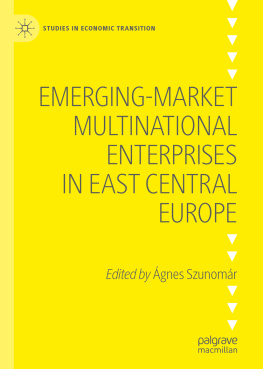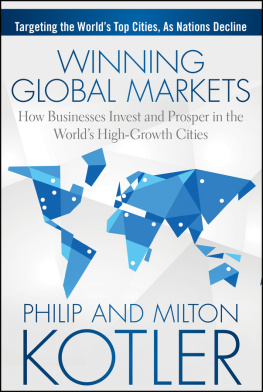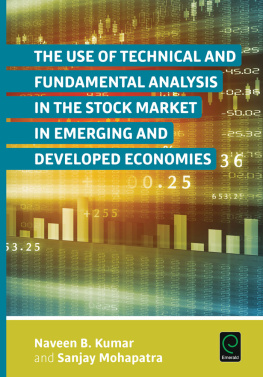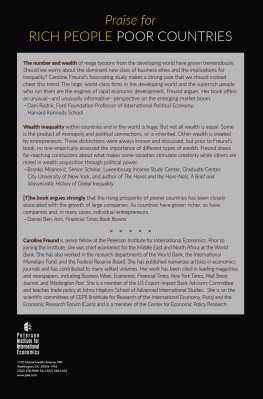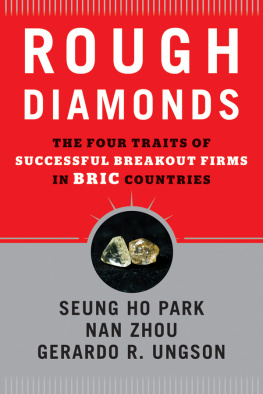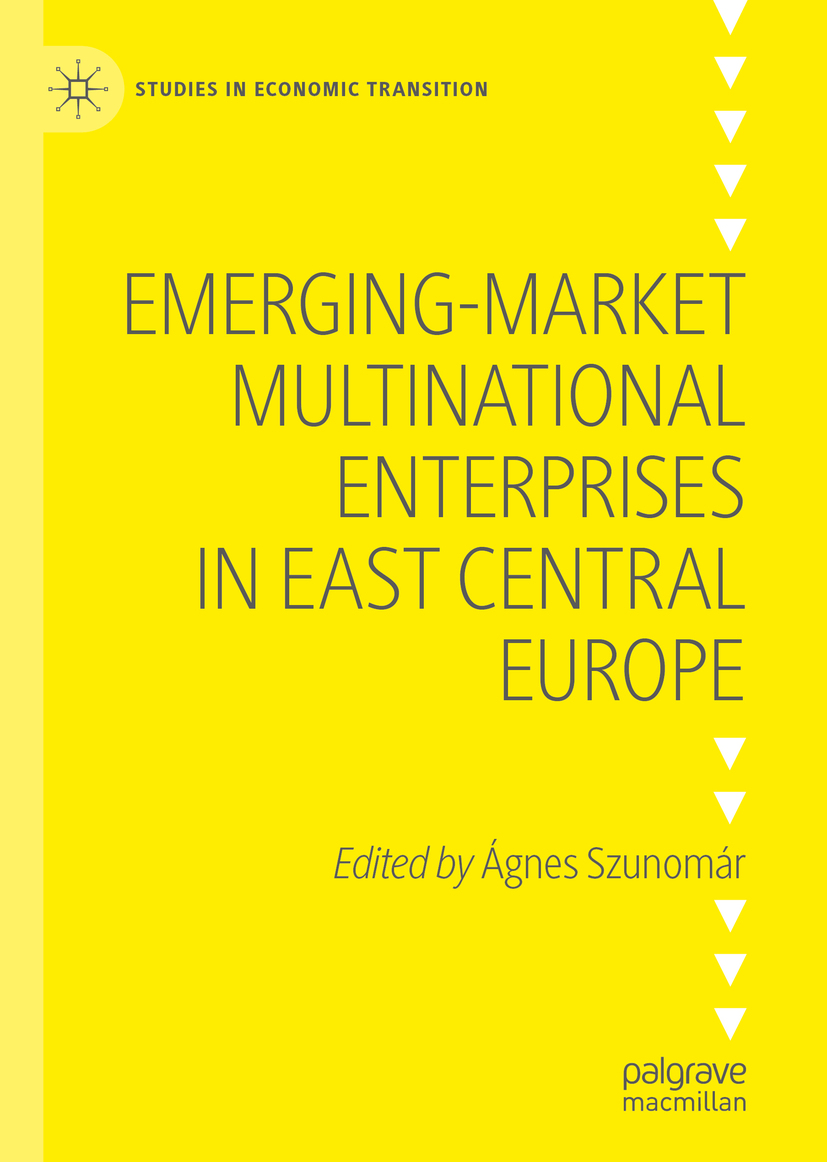Studies in Economic Transition
Series Editors
Jens Hlscher
The Business School, Bournemouth University, Bournemouth, Dorset, UK
Horst Tomann
Department of Economic Policy and Economic History, Freie Universitaet (FU) Berlin, Berlin, Germany
This series brings together theoretical and empirical studies on the transformation of economic systems and their economic development. The transition from planned to market economies is one of the main areas of applied theory because in this field the most dramatic examples of change and economic dynamics can be found. It is aimed to contribute to the understanding of specific major economic changes as well as to advance the theory of economic development. The implications of economic policy will be a major point of focus.
More information about this series at http://www.palgrave.com/gp/series/14147
Emerging-market Multinational Enterprises in East Central Europe
1st ed. 2020

Logo of the publisher
Editor
gnes Szunomr
Institute of World Economics, Centre for Economic and Regional Studies, Budapest, Hungary
Institute of International, Political, and Regional Sciences, Corvinus University of Budapest, Budapest, Hungary
ISSN 2662-6675 e-ISSN 2662-6683
Studies in Economic Transition
ISBN 978-3-030-55164-3 e-ISBN 978-3-030-55165-0
https://doi.org/10.1007/978-3-030-55165-0
The Editor(s) (if applicable) and The Author(s), under exclusive license to Springer Nature Switzerland AG 2020
This work is subject to copyright. All rights are solely and exclusively licensed by the Publisher, whether the whole or part of the material is concerned, specifically the rights of translation, reprinting, reuse of illustrations, recitation, broadcasting, reproduction on microfilms or in any other physical way, and transmission or information storage and retrieval, electronic adaptation, computer software, or by similar or dissimilar methodology now known or hereafter developed.
The use of general descriptive names, registered names, trademarks, service marks, etc. in this publication does not imply, even in the absence of a specific statement, that such names are exempt from the relevant protective laws and regulations and therefore free for general use.
The publisher, the authors and the editors are safe to assume that the advice and information in this book are believed to be true and accurate at the date of publication. Neither the publisher nor the authors or the editors give a warranty, expressed or implied, with respect to the material contained herein or for any errors or omissions that may have been made. The publisher remains neutral with regard to jurisdictional claims in published maps and institutional affiliations.
This Palgrave Macmillan imprint is published by the registered company Springer Nature Switzerland AG.
The registered company address is: Gewerbestrasse 11, 6330 Cham, Switzerland
Preface
The change of East Central European (ECE) countries from centrally planned to market economies resulted in increasing inflows of foreign direct investment (FDI) to these transition countries. During the transition, the region went through radical economic changes, which had been largely induced by foreign capital. Foreign multinationals realized significant investment projects in ECE and established their own production networks. Investors, mainly from core European Union countries, were attracted by macroeconomic factors such as relatively low unit labour costs, market size, openness to trade and proximity. When it comes to institutional factors that influence inward FDI, the prospects of ECE countries economic integration with the EU have already increased FDI inflows into the region.
Although the majority of investors arrived from Western Europe, the first phase of inward Asian FDI came also right after the transition, as Japanese and Korean companies indicated their willingness of investing in the ECE region already before the fall of the Iron Curtain. The second phase came after the New Millennium, when the Chinese government initiated the going global policy, which was aimed at encouraging domestic companies to become globally competitive, while Indian as well as other MNEs also made their first investment attempts in the ECE region already in the early 2000s.
Today, the rise of emerging-market MNEs is driven by the Asian economy, mainly China and India; however, this process is broader, incorporates a growing number of developing economies and is complemented by the growing share of emerging markets in world exports. In addition, emerging MNEs have become important players in several regions around the globe, ranging from the least developed countries of Africa through the developing markets in Latin America and Asia to the developed countries of the United States or the European Union, including East Central Europe. The ECE region is indeed a possible gateway to Europe for emerging MNEs. At the same time, the ECE regions appetite for investment is still significant, and emerging MNEs are offering an alternative source.
This volume brings together a collection of selected original studies conducted in the framework of the research project Non-European Emerging-Market Multinational Enterprises in East Central Europe supported by the National Research, Development and Innovation Office (NKFIH) of Hungary . Topics include the main theories of internationalization and foreign direct investment, the global patterns and recent trends of emerging MNEs as well as home and host country determinants behind the international expansion strategies of emerging companies. Besides its global focus, the volume maps out emerging countries investment flows and types of involvement, and identifies the motivations of emerging MNEs transactions in East Central Europe. Chapters present how pull determinants of emerging MNEs investments differ from that of Western companies in terms of specific institutional and political factors that seem important for some of the emergingespecially Chinesecompanies. This hypothesis echoes the call to combine macroeconomic and institutional factors for a better understanding of internationalization of companies.
This volume represents the first-ever attempt to systematically analyse emerging market multinationals investment into European emerging countries. This type of investments, as we believe, differ from both emerging MNEs investment into the core European countries and developed MNEs investment into the emerging regions of Europe. An additional novelty of the research endeavour is that besides macroeconomic and institutional factors it incorporates political factors into the analysis which may also have an important role to play in attracting emerging, especially Chinese, companies to a certain region.
After this brief introduction to our research, the first section of the volume includes two chapters. Szunomrs chapter presents a review of the main scientific literature relating to the traditional and new theories of internationalization and foreign direct investment while Szanyis chapter analyses the changing trends and patterns of foreign direct investments in East Central Europe. The following chaptersin two separate sectionsexamine several emerging country case studies by discussing the driving forces behind their international expansion strategies, focusing on these companies global as well as European investments, with a special focus on the major host country determinants of East Central Europe, using various statistics as well as company interviews.

